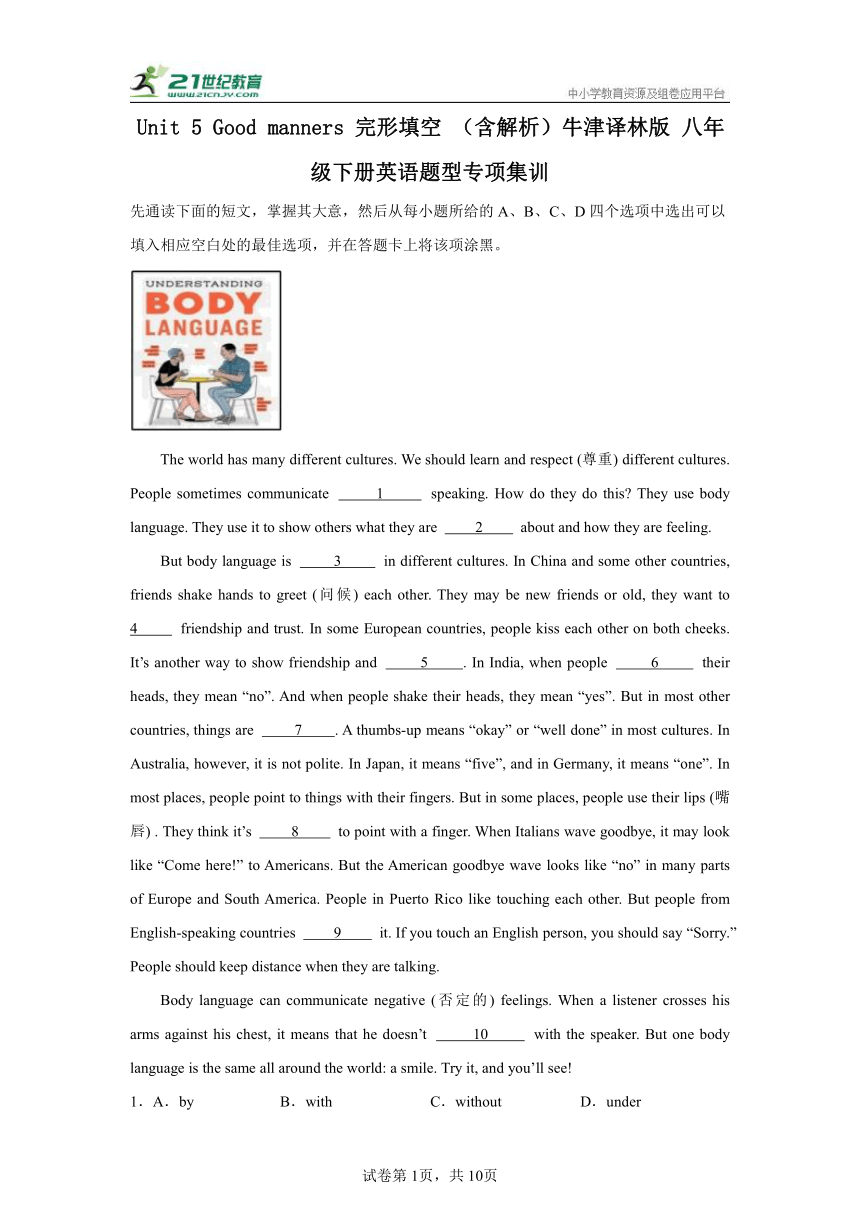
Unit 5 Good manners 完形填空 (含解析)牛津译林版 八年级下册英语题型专项集训 先通读下面的短文,掌握其大意,然后从每小题所给的A、B、C、D四个选项中选出可以填入相应空白处的最佳选项,并在答题卡上将该项涂黑。 The world has many different cultures. We should learn and respect (尊重) different cultures. People sometimes communicate 1 speaking. How do they do this They use body language. They use it to show others what they are 2 about and how they are feeling. But body language is 3 in different cultures. In China and some other countries, friends shake hands to greet (问候) each other. They may be new friends or old, they want to 4 friendship and trust. In some European countries, people kiss each other on both cheeks. It’s another way to show friendship and 5 . In India, when people 6 their heads, they mean “no”. And when people shake their heads, they mean “yes”. But in most other countries, things are 7 . A thumbs-up means “okay” or “well done” in most cultures. In Australia, however, it is not polite. In Japan, it means “five”, and in Germany, it means “one”. In most places, people point to things with their fingers. But in some places, people use their lips (嘴唇) . They think it’s 8 to point with a finger. When Italians wave goodbye, it may look like “Come here!” to Americans. But the American goodbye wave looks like “no” in many parts of Europe and South America. People in Puerto Rico like touching each other. But people from English-speaking countries 9 it. If you touch an English person, you should say “Sorry.” People should keep distance when they are talking. Body language can communicate negative (否定的) feelings. When a listener crosses his arms against his chest, it means that he doesn’t 10 with the speaker. But one body language is the same all around the world: a smile. Try it, and you’ll see! 1.A.by B.with C.without D.under 2.A.worrying B.hearing C.writing D.thinking 3.A.important B.different C.hard D.possible 4.A.understand B.find C.show D.learn 5.A.excitement B.love C.pity D.sadness 6.A.nod B.move C.shake D.turn 7.A.unusual B.surprising C.opposite D.boring 8.A.great B.clever C.useless D.rude 9.A.enjoy B.refuse C.realize D.accept 10.A.agree B.fight C.help D.talk The “666” emoji (表情符号) 11 on WeChat at the end of 2020. It is getting 12 among both Chinese and Western WeChat users — but for different reasons. It shows a smiling face holding up the Chinese hand sign for “6” with the 13 “666” next to it. The emoji has an active meaning because Chinese character for “six” is sounds like the same way as “liu liu dashun”. People use it to show the reason of giving 14 wishes to their friends or relatives. But in some Western countries, “666” has a very 15 meaning. It is said “666” was the “Mark of the Beast (野兽)”. The devil (恶魔) 16 people to wear it in order to show their loyalty (忠诚) to him, although it was 17 people’s wishes. That’s why some ... ...
~~ 您好,已阅读到文档的结尾了 ~~

